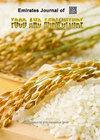结合作物模型和遥感技术划定水稻产量和生产范围
IF 0.7
4区 农林科学
Q3 AGRONOMY
引用次数: 0
摘要
该研究旨在利用地理信息系统、遥感技术和水稻模型,模拟各地的水稻产量,并勾勒出研究地区的水稻产量图。作为案例研究,收集了安江省(越南湄公河三角洲南部)的气候、土壤特性和水稻种植状况的数据。AquaCrop 模型用于预测水稻产量。MODIS 图像根据空间和时间 NDVI 值划分了水稻种植状况。然后将产量模拟结果与水稻种植地点、天气和土壤特性等信息结合起来,绘制出产量分布图。最后,在最后一步将结果与统计结果进行验证和对比。对水稻产量进行预测,并与实际 1%和 6%的水稻产量进行对比。为 2012-2013 年冬春耕作季、2013 年夏秋耕作季和秋冬耕作季绘制了预期水稻产量图。水稻生产和产量分布可分为两大区域。由于土壤和气候条件的差异,冲积土地区的水稻产量明显高于龙圩四合院地区。结合遥感和作物模型进行水稻产量模拟和划分,是一个国家或地区进行产量预测和制定更好的农业管理策略的好方法。结果的准确性取决于土壤气象和遥感等输入数据的质量。 关键词地理信息系统 MODIS 作物季节 水稻产量本文章由计算机程序翻译,如有差异,请以英文原文为准。
Delineation of Rice Yield and Production in Combination of Crop Model and Remote Sensing
The study was to simulate rice yield in various places and outline a rice yield map for the study area using GIS, remote sensing, and a rice model. As a case study, the data were collected on the climate, soil characteristics, and rice cropping status in the AnGiang province (Southern of the Mekong River Delta in Viet Nam). The AquaCrop model was used to predict rice yield. The MODIS image delineated the rice cropping status based on spatial and temporal NDVI values. The results of the yield simulation are then put together with information about where the rice was planted, the weather, and the properties of the soil to make a map of the yield distribution. Finally, the outcomes are verified and contrasted with the statistical findings in the last step. The rice yield was predicted and compared with actual 1 and 6 percent rice yields. The anticipated rice yield map was established for the Winter-Spring cropping season 2012-2013 and the Summer-Autumn and Autumn–Winter cropping seasons 2013. Rice production and yield distribution can be divided into two major areas. The alluvial soil area produces significantly more rice than the LongXuyen quadrangle area because of the difference in soil and weather conditions. Rice yield simulation and delineation combining remote sensing and crop models is a good approach for yield prediction and better agricultural management strategy development in a country or region. The accuracy of the results depends on the quality of the input data, such as soil weather and remote sensing. Keywords: GIS, MODIS, cropping season, rice yield
求助全文
通过发布文献求助,成功后即可免费获取论文全文。
去求助
来源期刊

Emirates Journal of Food and Agriculture
AGRONOMYFOOD SCIENCE & TECHNOLOGY&nb-FOOD SCIENCE & TECHNOLOGY
CiteScore
1.80
自引率
0.00%
发文量
18
期刊介绍:
The "Emirates Journal of Food and Agriculture [EJFA]" is a unique, peer-reviewed Journal of Food and Agriculture publishing basic and applied research articles in the field of agricultural and food sciences by the College of Food and Agriculture, United Arab Emirates University, United Arab Emirates.
 求助内容:
求助内容: 应助结果提醒方式:
应助结果提醒方式:


